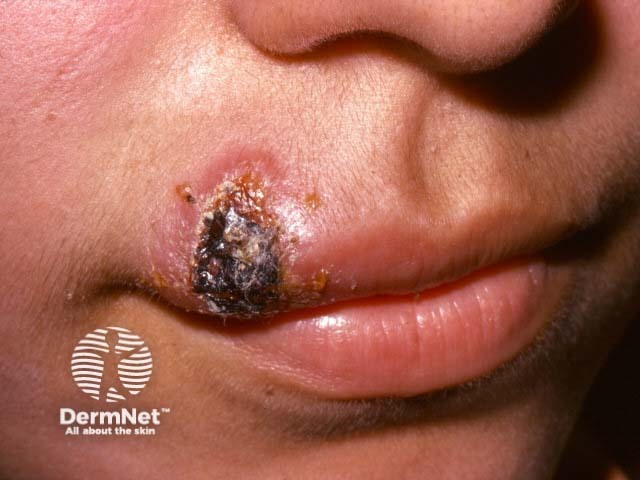Main menu
Common skin conditions

NEWS
Join DermNet PRO
Read more
Quick links
Author: Vanessa Ngan, Staff Writer, 2005. Updated by Dr Catriona Wootton, Dermatologist, UK, January 2017.
Introduction Demographics Classifications and causes Clinical features Diagnosis Differential diagnoses Treatment Prevention
Leishmaniasis is a parasitic disease transmitted by sandflies infected with the protozoa Leishmania. Leishmaniasis is endemic in more than 70 countries worldwide and affects an estimated 12 million people.
There are several clinical forms of leishmaniasis. The clinical manifestation of the infection depends on the species of Leishmania, which varies with geographical area and the host’s immune response.
Parasites causing human leishmaniasis are not found in New Zealand, Australia, the South Pacific, or Antarctica.



See more images of leishmaniasis.
People of all ages, living or travelling through areas where sandflies and Leishmania species are endemic are at risk of infection with leishmaniasis. Living in rural areas and spending time on or near the ground increases the risk.
There are more than 20 species of Leishmania parasites which can infect humans; transmitted via the bite of phlebotomine sandflies. Sandflies are tiny (1.5–3 mm) insects which actively feed on blood at dawn and dusk. Sandflies live in wall cracks, animal burrows and leaf litter, in tropical and sub-tropical regions. Their bite is asymptomatic and classically on exposed sites.
Leishmaniasis has several recognised clinical forms, and their manifestation depends upon the species inoculated and the host’s immune response. The most important distinction is between American and non-American species of Leishmania, as the Viannia subspecies found in the Americas, can result in mucocutaneous leishmaniasis.
Cutaneous leishmaniasis typically occurs at the site of inoculation. The presentation and prognosis will vary depending on the species involved.
Non-American (Old World) cutaneous leishmaniasis:
American (New World) cutaneous leishmaniasis:
Mucocutaneous leishmaniasis is a destructive form of leishmaniasis, which is only seen with the American species of Leishmania (Viannia subspecies).
American mucocutaneous leishmaniasis:
Diffuse cutaneous leishmaniasis is a rare presentation resulting from an anergic response to the parasite by the host.
Non-American diffuse cutaneous leishmaniasis:
American diffuse cutaneous leishmaniasis:
Visceral leishmaniasis results from the involvement of the internal organs and is usually fatal if untreated. It is also known as kala-azar or Dumdum fever.
Non-American visceral leishmaniasis:
American visceral leishmaniasis:
Post-kala-azar dermal leishmaniasis is a form of cutaneous leishmaniasis that can occur months to years after treatment of visceral leishmaniasis.
Non-American post-kala-azar dermal leishmaniasis:
American post-kala-azar dermal leishmaniasis:
Leishmaniasis recidivans is a rare, cutaneous form of leishmaniasis, occurring in patients with a good cellular immune response. It is also known as lupoid leishmaniasis.
Non-American leishmaniasis recidivans:
American leishmaniasis recidivans:







Diagnosis of cutaneous leishmaniasis is usually based on the history and clinical appearance of the lesion. A comprehensive travel history, including historical travel due to the long incubation period, is important in non-endemic areas. The diagnosis can be confirmed by identifying the parasite on biopsy or split skin smear. Culture and PCR may also be used to confirm the diagnosis and identify the species of Leishmania, which is important when there is a risk of mucocutaneous leishmaniasis.
Serology is used to confirm the diagnosis in visceral leishmaniasis.
In over 70% of cases, a full-thickness skin biopsy can reveal the parasite. Histopathology is also used to establish mucocutaneous leishmaniasis and visceral leishmaniasis. Complete blood counts and liver function tests should also be performed in visceral leishmaniasis.

Ulcer


Ulcer
The variety of clinical manifestations of cutaneous leishmaniasis results in a wide range of differential diagnoses:
In cutaneous leishmaniasis, treatment options differ depending on whether the lesion/s is considered simple or complex.
In non-American cutaneous leishmaniasis, lesions are considered complex if they are larger than 4 cm, multiple, associated with lymphatic spread, persistent (> 6 months), in immunosuppressed individuals, situated over joints, or in cosmetically sensitive areas.
All cases of American leishmaniasis should be considered complex because of the risk of mucocutaneous leishmaniasis with the Viannia subspecies.
Treatment options for cutaneous leishmaniasis lesions include:
Most cases of simple cutaneous leishmaniasis will resolve spontaneously without treatment, but this may take many months and can result in scarring.
Systemic antimonials are the mainstay of treatment for complex cutaneous leishmaniasis lesions, mucocutaneous leishmaniasis, and visceral leishmaniasis. They cannot be given orally, and the length of treatment may be up to 28 days for mucosal lesions. Treatment requires hospital admission, and there is a risk of side effects, including cardiotoxicity.
Secondary wound infections should be treated with appropriate antimicrobial therapy.
Surgical treatments and vaporising laser treatments are also used for appropriate lesions.
Refer to guidelines on the management of leishmaniasis published by the Infectious Diseases Society of America (IDSA) and the American Society of Tropical Medicine and Hygiene (ASTMH) (December 2016).
Infection can be prevented by avoidance of sandfly bites. Because there are currently no vaccines or drugs for preventing infection, travellers to areas where leishmaniasis is prevalent should decrease their risk of being bitten by adhering to the following precautionary measures.